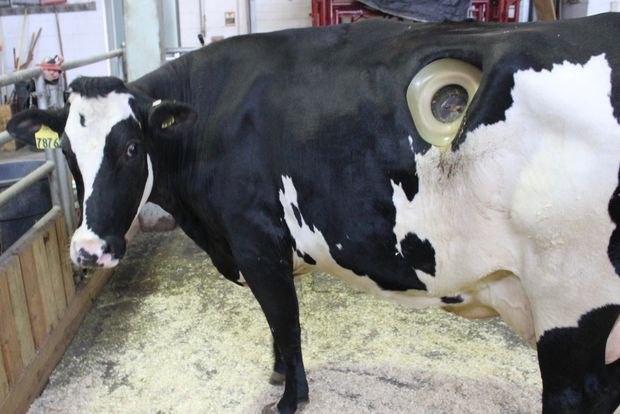MOUNT GREENWOOD — Hole-y Cow.
A cannulated dairy cow arrived Thursday evening at the Chicago High School for Agricultural Sciences in Mount Greenwood. The three-year-old cow is surgically fitted with a cannula — a port used to study its stomach contents.
The unnamed cow was quickly getting comfortable with her new surroundings Friday in the barn at 3857 W. 111th St., said Samantha Kujawa, an animal science teacher at the school.
In a couple weeks, the port will be opened, allowing students to peer inside the roughly 1,500-pound cow's rumen, the largest part of the animal's four-chambered stomach, Kujawa said.

The installation of a cannula or port within cows is a procedure that dates to the 1920s. This cow arrived Thursday night at the Chicago High School for Agricultural Sciences in Mount Greenwood. [DNAinfo/Howard A. Ludwig]
"You can actually see the function of the stomach," she said. "You can see what she is eating and what she has eaten. You can feel the inside of her rumen."
Indeed, students will also be able to reach into the port while wearing a sanitary glove. They'll be able to feel the stomach contents, lining and even the blood vessels near the animal's spine, Kujawa said.
The port also allows students to remove feed from within the stomach cavity for study, a possibility that fascinated seniors Lucio Barrera and Daymond Hunter Friday morning.
"She will help people learn and help us better take care of cows," said Hunter, pointing to the veterinary benefits of having the animal on campus.

Its common for some stomach fluid and food remnants to seep out of a cow with a cannula or stomach port, said Samantha Kujawa, an animal science teacher at the Chicago High School for Agricultural Sciences. [DNAinfo/Howard A. Ludwig]
Cannulated or fistulated cows date to the 1920s. Kujawa compared the installation of the rubber port to the installations of ports commonly used to deliver medicine in humans. The procedure is done under minor anesthesia.
Animals fitted with a cannula have life spans similar to other cows, she said, adding that the rubber port is not uncomfortable for the animal nor is the periodic probing of the cavity. Still, animal rights activists have taken issue with the practice.

The port on the side of this cow at the Chicago High School for Agricultural Sciences allows students to reach inside the animal to feel the contents of its stomach. The 3-year-old dairy cow was donated to the school from the University of Wisconsin at Madison. [DNAinfo/Howard A. Ludwig]
Students will be responsible for keeping the cannula clean and will pay close attention to the cows' weight using a large scale that also arrived Thursday, Kujawa said. The dairy cow had a calf prior to the installation of the port in February 2016, she said.
The cannulated cow was donated to the Ag School by the University of Wisconsin at Madison. The animal is expected to spend the rest of her life on the school's campus on the Far Southwest Side, Kujawa said.
The university "graciously gave it to us for teaching," she said.




















